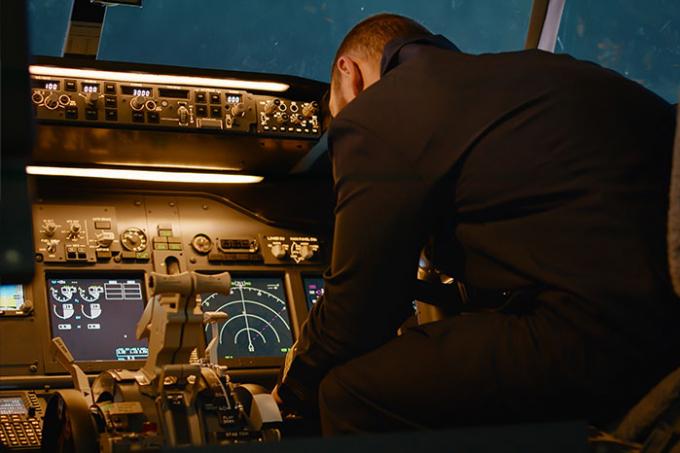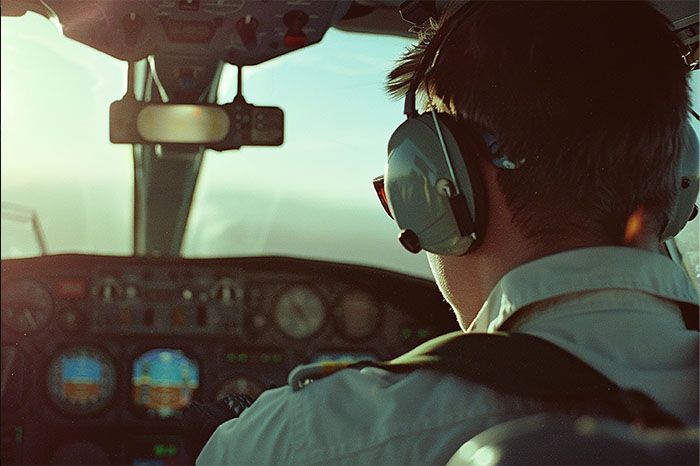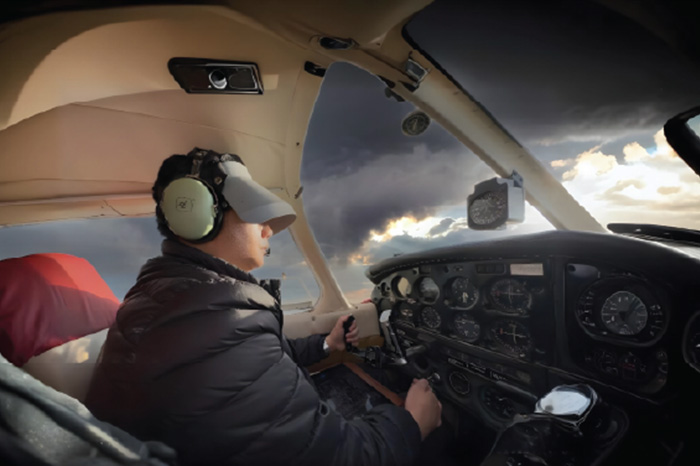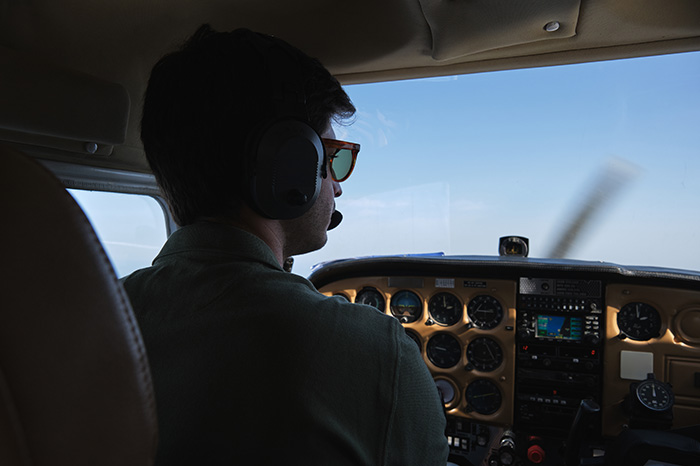

Pilot Monitoring Aircraft Instrument (Source: Freepik/harsh2030fp)
Spatial disorientation occurs when a pilot's perception of direction does not align with reality. This condition typically happens when visual references are limited or absent, such as during night flights or in Instrument Meteorological Conditions (IMC).
Read More: How to Land an Airplane for Solo Flight: A Beginner’s Guide
In aviation, spatial disorientation can have serious implications, as pilots may misjudge their aircraft's attitude, altitude, or speed. This condition highlights the importance of thorough training and instrument reliance to ensure safe and accurate navigation, particularly in challenging conditions.

Spatial Disorientation Symptoms (Source: Freepik/9nong)
Spatial disorientation symptoms vary depending on the individual and the situation. However, common indicators include:
A false sense of pitch, roll, or yaw of the aircraft.
Confusion about the aircraft's position in space.
Dizziness or vertigo, often triggered by inner ear disturbances.
Nausea or a feeling of imbalance
Recognizing these symptoms early is vital for pilots to take corrective action before the situation worsens.
Spatial disorientation arises from the limitations of the human sensory system. Here are the main causes:
The inner ear's vestibular system can create illusions, especially during rapid accelerations or decelerations. For instance, a pilot might feel as if the aircraft is climbing when it’s actually in level flight.
Flying in poor visibility, such as fog, clouds, or at night, deprives pilots of the external visual references needed for orientation.
Rapid turns or turbulence can confuse the brain, leading to incorrect spatial awareness.

Managing Spatial Disorientation (Source: 14DAYPILOT Documentation)
Flight training is the perfect time to learn how to recognize and manage spatial disorientation. Here are some techniques to handle it effectively:
Pilots are trained to rely on their instruments rather than their senses, especially in IMC. Instruments provide accurate information about altitude, speed, and attitude, even when sensory inputs are misleading.
Panicking can worsen the effects of spatial disorientation. Pilots are taught to stay composed and follow established procedures to regain control.
Flight instructors play a critical role in exposing students to scenarios that simulate spatial disorientation, helping them build confidence in dealing with such situations.
Read More: Stress Management for Pilots: Handle Pressure with Confidence

Advanced Training Methods (Source: Freepik/Addictive Stock)
Modern flight training incorporates advanced techniques to help pilots handle spatial disorientation:
Simulators provide a safe environment to recreate disorientation scenarios. Trainees can practice identifying and correcting sensory illusions without real-world risks.
Emphasis on instrument interpretation builds the skills needed to overcome spatial disorientation in actual flight conditions.
Realistic scenarios, such as IMC or nighttime operations, teach pilots to manage disorientation while building confidence and resilience.
Spatial disorientation doesn't just have immediate physical effects; it can also leave psychological scars. Pilots who have experienced severe disorientation may develop post-traumatic stress disorder (PTSD), characterized by anxiety, flashbacks, or fear of flying.
To address this, pilots are encouraged to seek professional help and participate in debriefing sessions to process their experiences. Maintaining mental health is a key part of staying safe and effective in the cockpit.
Spatial disorientation is a challenge that every pilot must be prepared to face. By understanding its causes and symptoms, practicing effective management techniques, and undergoing rigorous training, pilots can mitigate its risks. During flight training, aspiring pilots should take every opportunity to learn how to recognize and correct disorientation, ensuring their safety and that of their passengers.
Mastering spatial disorientation and honing your instrument flying skills is essential for safe and confident piloting. The 14DAYPILOT Instrument Rating Program is designed to equip you with the knowledge and expertise needed to handle challenging flight conditions. With accelerated training tailored to your schedule, you can achieve precision and confidence in just a few days. Don't wait! Take the next step in your aviation journey today!

Spatial disorientation is a significant challenge that pilots face, especially during flight training. Understanding its causes, symptoms, and management techniques is crucial for ensuring safety in the skies. In this article, we’ll explore spatial disorientation, its symptoms, prevention strategies, and the role of training in overcoming this common issue.

Pilot Monitoring Aircraft Instrument (Source: Freepik/harsh2030fp)
Spatial disorientation occurs when a pilot's perception of direction does not align with reality. This condition typically happens when visual references are limited or absent, such as during night flights or in Instrument Meteorological Conditions (IMC).
Read More: How to Land an Airplane for Solo Flight: A Beginner’s Guide
In aviation, spatial disorientation can have serious implications, as pilots may misjudge their aircraft's attitude, altitude, or speed. This condition highlights the importance of thorough training and instrument reliance to ensure safe and accurate navigation, particularly in challenging conditions.

Spatial Disorientation Symptoms (Source: Freepik/9nong)
Spatial disorientation symptoms vary depending on the individual and the situation. However, common indicators include:
A false sense of pitch, roll, or yaw of the aircraft.
Confusion about the aircraft's position in space.
Dizziness or vertigo, often triggered by inner ear disturbances.
Nausea or a feeling of imbalance
Recognizing these symptoms early is vital for pilots to take corrective action before the situation worsens.
Spatial disorientation arises from the limitations of the human sensory system. Here are the main causes:
The inner ear's vestibular system can create illusions, especially during rapid accelerations or decelerations. For instance, a pilot might feel as if the aircraft is climbing when it’s actually in level flight.
Flying in poor visibility, such as fog, clouds, or at night, deprives pilots of the external visual references needed for orientation.
Rapid turns or turbulence can confuse the brain, leading to incorrect spatial awareness.

Managing Spatial Disorientation (Source: 14DAYPILOT Documentation)
Flight training is the perfect time to learn how to recognize and manage spatial disorientation. Here are some techniques to handle it effectively:
Pilots are trained to rely on their instruments rather than their senses, especially in IMC. Instruments provide accurate information about altitude, speed, and attitude, even when sensory inputs are misleading.
Panicking can worsen the effects of spatial disorientation. Pilots are taught to stay composed and follow established procedures to regain control.
Flight instructors play a critical role in exposing students to scenarios that simulate spatial disorientation, helping them build confidence in dealing with such situations.
Read More: Stress Management for Pilots: Handle Pressure with Confidence

Advanced Training Methods (Source: Freepik/Addictive Stock)
Modern flight training incorporates advanced techniques to help pilots handle spatial disorientation:
Simulators provide a safe environment to recreate disorientation scenarios. Trainees can practice identifying and correcting sensory illusions without real-world risks.
Emphasis on instrument interpretation builds the skills needed to overcome spatial disorientation in actual flight conditions.
Realistic scenarios, such as IMC or nighttime operations, teach pilots to manage disorientation while building confidence and resilience.
Spatial disorientation doesn't just have immediate physical effects; it can also leave psychological scars. Pilots who have experienced severe disorientation may develop post-traumatic stress disorder (PTSD), characterized by anxiety, flashbacks, or fear of flying.
To address this, pilots are encouraged to seek professional help and participate in debriefing sessions to process their experiences. Maintaining mental health is a key part of staying safe and effective in the cockpit.
Spatial disorientation is a challenge that every pilot must be prepared to face. By understanding its causes and symptoms, practicing effective management techniques, and undergoing rigorous training, pilots can mitigate its risks. During flight training, aspiring pilots should take every opportunity to learn how to recognize and correct disorientation, ensuring their safety and that of their passengers.
Mastering spatial disorientation and honing your instrument flying skills is essential for safe and confident piloting. The 14DAYPILOT Instrument Rating Program is designed to equip you with the knowledge and expertise needed to handle challenging flight conditions. With accelerated training tailored to your schedule, you can achieve precision and confidence in just a few days. Don't wait! Take the next step in your aviation journey today!
Ilham Febrian is a dedicated aviation blogger with a strong interest and high expectations for the aviation industry. He holds a DGCA Commercial Pilot license with Airbus A320 type rating. Continuously updated with the latest aviation news, Ilham strives to provide top-quality content on the website, aimed at assisting all pilots. The website focuses on offering flight training guidance, information on flying school materials, and tips on how students can successfully pass their check rides.
Ilham Febrian is a dedicated aviation blogger with a strong interest and high expectations for the aviation industry. He holds a DGCA Commercial Pilot license with Airbus A320 type rating. Continuously updated with the latest aviation news, Ilham strives to provide top-quality content on the website, aimed at assisting all pilots. The website focuses on offering flight training guidance, information on flying school materials, and tips on how students can successfully pass their check rides.